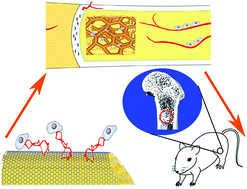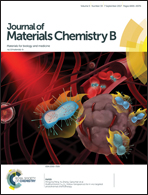A 3D graphene coated bioglass scaffold for bone defect therapy based on the molecular targeting approach†
Abstract
Development of a cell-free scaffold with excellent mechanical properties and osteoconductivity is of significant need for bone regeneration. Herein, a reduced graphene oxide (rGO) functionalized hierarchical macro–mesoporous bioactive glass scaffold integrated with an osteoblast-specific aptamer is rationally designed to recruit and induce the rapid differentiation of osteoblasts for bone regeneration. This scaffold exhibits a macroporous structure with fully interconnected open pores and shows excellent mechanical properties with a Young's modulus of ∼80 kPa, which provides a strong scaffold to support the growth of osteoblasts and bone tissue regeneration. Furthermore, the scaffold displays good performance in accelerating osteoblast differentiation and promoting new bone formation. The osteoblast recruitment is achieved since the osteoblast-specific aptamer can specifically target osteoblasts with strong binding affinity. Micro-computed tomography and histological tests confirmed that the large bone defects fully heal with new plate-like-pattern bone appearing both peripherally and centrally, suggesting the outstanding bone regeneration performance of this cell-free and graphene functionalized scaffold. Considering the promising bioapplications of the graphene functionalized bioactive glass scaffold with osteoblast recruitment capacity, our strategy paves a way for the design of new bioactive functional materials for tissue regeneration and shows attractive prospects in targeted therapy.



 Please wait while we load your content...
Please wait while we load your content...